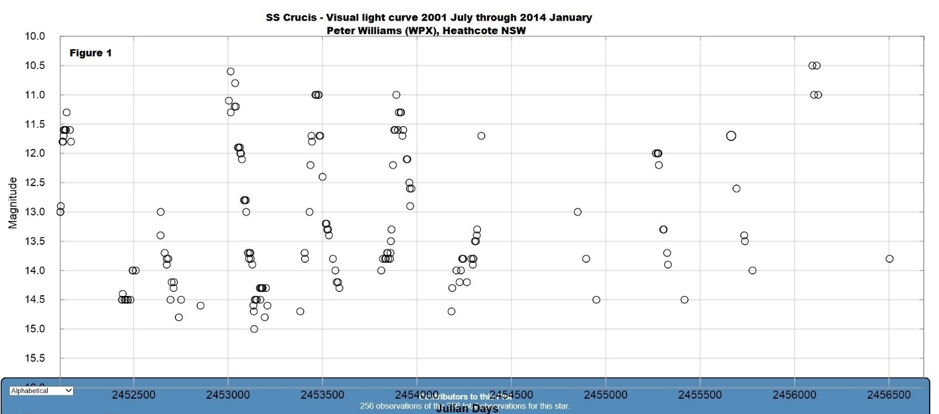SS Crucis—Reflections on a Forgotten Mira Variable
By Peter Williams
Most of us who are members of and contribute observations to the AAVSO receive the weekly Data Usage Report—an email that lists the stars of which your observations have been downloaded from the AAVSO International Database, and an indicator of the intended purpose for which the data is to be used. A quick look through these reports is interesting, as they show the wide variety of stars in which researchers, educators, and students are interested. They also provide satisfaction that our observations, when reported, are indeed of value.
Most often, the downloaded data is in groups of a particular variable star class: novae, RCB stars, Cepheid or Mira stars, etc. Occasionally, for whatever reason, one star in particular stands out. A star that recently caught my eye is SS Cru, and this prompted me to look back at my visual data.
SS Cru is one of a number of southern Mira stars that was listed in the GCVS as “not studied” (for which there is no known type, period, or epoch for determining the date of maximum brightness). Back in the mid-1990s, I selected around two dozen of these “not studied” Miras, and added them to my regular working list with the aim of, firstly, detecting and identifying them, as their positions were often poorly measured or simply in error, then following up by making regular observations to determine the basic parameters of their variations. This is hardly earth-shattering research, and it was merely aimed at filling in a few of the missing gaps in the catalogue’s data.
The problem with any such program on Mira stars is, of course, that as these stars have cycles close to a year or longer, it can take a decade or so to accumulate enough observations to adequately determine the star’s behaviour, and much longer to investigate any trends or changes that may occur. First results for this unofficial program were of NSV4189 Hydrae, and were published in VSS RASNZ Publications No. 24 (2000). The star subsequently received the official GCVS designation of V371 Hya.
SS Cru was discovered in May 1920, on the Union Observatory Plates of the Circulars of the Union Observatory, Johannesburg. It was was reported by Harry E. Wood (not to be confused with Harley Wood, who I originally credited as the reporter in this article, and who became NSW Government Astronomer at the Sydney Observatory—thanks to Mati Morel for clarifying the difference between these two early 20th century astronomers) as a star of photographic range 12.8 to fainter than 15, but with no type, period, or epoch for maximum. There was no apparent follow up during the subsequent 80 years.
I added SS Cru to my working list in March of 2000. The first positive sighting was not until four months later on July 19th, at a position somewhat different to the catalogued position. This detection was reported through the VSNET of Kyoto University (vsnet-chat 4695, 2001 Aug 05). V-magnitudes for the lettered comparison stars were kindly measured by Colin Bembrick at his Mount Tarana Observatory, Napoleon Reef, NSW.
During the following seven years, through to January of 2014, a total of 249 observations were made and reported to the AAVSO. For clarity, only the positive data points are plotted as the light curve (Figure 1). Of those 249 observations, a mean cycle of 443.6 days is evident, with the usual cycle-to-cycle variations typical for long-period Mira stars.

Figure 1. Visual light curve of SS Cru, obtained at Heathcote NSW, on which only the positive observations are plotted.
The upper limits, negative or fainter-than observations (Figure 2), exclude the possibility of a shorter mean cycle that could occur due to a seasonal gap in the data. The visual range of 10.5 to fainter than 15 is evident.

Figure 2. Visual light curve of SS Cru, obtained at Heathcote NSW, showing both positive magnitude measurements and upper limits where the star was invisible and fainter than the value shown.
The intention was to publish the results for SS Cru and other similar “unloved” southern Miras through either the Variable Stars South of the RASNZ or the AAVSO, thus continuing the series of results for stars previously published.
However, by the time sufficient visual data became available for these stars, there were a number of automatic sky surveys, both professional and amateur, in full swing. Data mining was swiftly filling in the catalogue's missing detail, unfortunately causing enthusiasm to quickly wane and the observation focus to change to other stars. It is important to note, however, that stars from this program for which results were published earlier include Cd-62 466 Car, DI Car, IY Car, V600 Car, YY & NSV19431 Cen, T CMa, EO Eri, SW Hor, V371 Hya, X Mus, and V407 Sco, therefore rendering the effort put into this modest program an achievement.
Quickly eyeballing several of the other dozen or so unloved southern Miras from that long-ago program, it is apparent that some may not be behaving as expected from the current VSX detail. So perhaps there is still more to be done with these visual observations, as we keep in mind that the catalogue data is only as good as the updates and observations available at any given time.
In the case of SS Cru, it is both interesting and satisfying to note the above mean visual period and magnitude range are in good agreement with the 441 days and 10.2 to fainter than 14V currently listed for SS Cru in the VSX of the AAVSO, and to wonder what the student who downloaded the observations is planning or hoping to achieve when analysing the data.

